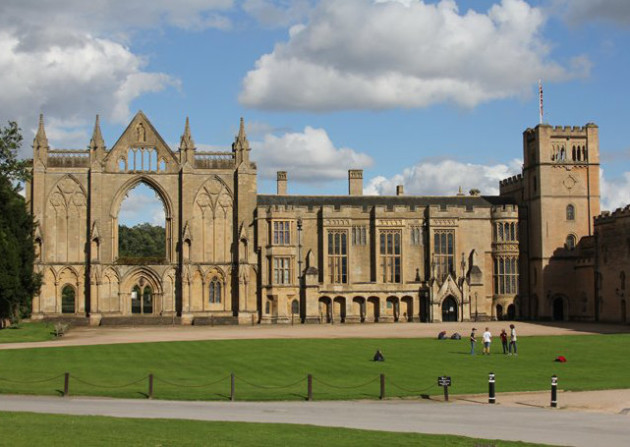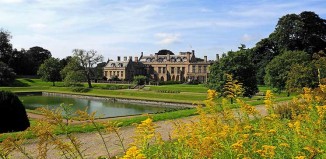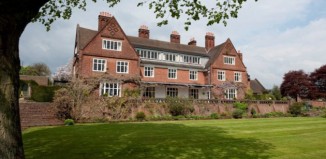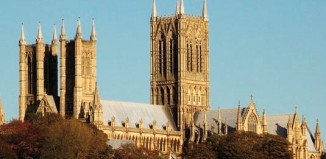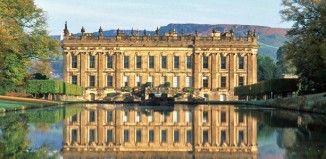Newstead Abbey
Vicky Sartain
In a fittingly romantic location just outside Nottingham, the home of George Gordon Byron is as mystifying and enigmatic as the man himself. Questions still linger about the poet’s time here, from 1808-14, with some intriguing personal effects providing the only tangible clues, along with the knowledge that he desired Newstead as his final resting place, albeit in vain.
The house was founded as an Augustinian priory in the 12th century by Henry II, serving for 400 years until the dissolution saw its closure in 1539 and sale to Sir John Byron of Colwick in 1540. Sir John took drastic measures to convert the building into a lavish family home. By 1545 the framework of the monastic house was moulded into a hybrid vision that took the best features of the priory, such as the iconic West Front façade of the original church, its crenulations, spires, cloisters and archways, combined with the Tudor fashions of the day.
Such was the Byron family’s reputation that prior to the poet inheriting the house from his scandalous great uncle William, 5th Lord Byron (1722-98), the neighbourhood had formed dismal expectations of him. The 5th Lord, or ‘Wicked Lord’ as he was widely known, had a tendency for cruel practical jokes, usually played on his unsuspecting staff. Taking pot shots at them by cannon fire or pistol was common – as were their subsequent deaths. Owing to his rank he also got away with the murder of his cousin after drunkenly challenging him to a duel in London.
It is only by a chance turn of events that the poet came to own Newstead at all, the result of family feuds and untimely deaths of next of kin, leaving no one left to take over. The 6th Lord Byron was only 20 when he came of age and claimed Newstead for his own, breathing life back into the house which had stood empty since his uncle’s death 10 years earlier.
“As an outgoing personality Byron was obviously going to enjoy himself, having just taken ownership of a country house,” says house steward Diane Turner. “With all his wild parties and debauchery the young poet liked shocking his neighbours, though there was nothing inherently wicked in his nature, despite his reputation as being ‘mad, bad, and dangerous to know’.”
Traits he did share with his uncle, however, were a love of spending money, and of guns, keeping a pistol by his bedside to ward off the odd cuckolded husband. A pet wolf-dog and tame rescue bear, Bruin, were other trusty guardians of the slumbering Lothario.
During medieval times Newstead was engulfed by the royal hunting ground of Sherwood Forest, and the kings of the age would have paused there for refreshment. Visitors of note would have been entertained in the Great Hall, which prior to the poet’s arrival, had been stripped of its sumptuous decoration right down to the fireplace, to pay off the gambling debts of his late uncle.
Owing to his profligate nature Byron’s stamp on the house was minimal, favouring instead to decorate smaller rooms that he used regularly such as his study, dressing room and bedroom, while larger areas were given over to indoor games and firing ranges. Beneath the panelling in the Great Hall, bullet holes in the stone give merit to the legend of Byron’s trigger-happy tendencies.
“The Drawing Room, the old monastic refectory, became the poet’s gymnasium for fencing, boxing and sword-fighting,” explains Diane. “In fact the only activity Byron steered clear of was dancing owing to his slight lameness, a birth defect. At parties he was known to make a grand entrance, but would stand haughtily on the sidelines – it is thought that this social faux pas inspired the creation of Jane Austen’s Mr Darcy in Pride and Prejudice.”
Perhaps the most fascinating decorative items that remain are the four intricately carved and vibrantly painted wooden overmantels dating to the 16th century. Featuring Saracens and maidens they are inscribed with the Latin motto Crede Byron or ‘Trust in Byron’. Their significance to the family remains a mystery, but the heirlooms were brought to Newstead from the ancestral home at Colwick Hall, (now a lavish hotel) in Nottingham.
One overmantel is restored to the Dining Room, a modest space still bearing the dark Neo-Gothic decoration installed by the first of Newstead’s Victorian owners, Thomas Wildman and his architect, John Shaw. In this room, Byron would have invited close friends only. Perhaps it was here that he decided that: ‘A woman should never be seen eating or drinking, unless it’s lobster salad and Champagne, the only true feminine and becoming viands’.
Footsteps echo as visitors pass from room to room, the priory foundations inches below, hiding their own secrets. The Byrons were convinced that the monks had squirreled their treasures in the grounds and the poet excavated the North Cloister many times in desperation. Although nothing of value was ever discovered, Byron did stumble upon the old priory graveyard, claiming a human skull as a morbid souvenir which he transformed into a claret goblet. A replica is exhibited in the Study; the original having been respectfully reburied on the property after Byron’s time.
Byron’s bedroom lay at the top of the house, well away from visiting friends and acquaintances, which assured him security and privacy. The view from his window looks over the picturesque lake, follies and wooded grounds beyond; the four-poster still hosts the poet’s original coverlet and drapes, while his bedroom wallpaper and carpet have been recreated to match the original.
The poet’s time at Newstead was relatively short. In 1814 after just six years he emigrated to Italy, abandoning the house and drawing to a close almost four centuries of his family’s ownership. In 1817 he sold up to his long-time friend Thomas Wildman who saved the house from near ruinous state, simultaneously alleviating the poet’s dire financial problems. Yet contrary to popular opinion, not all Byron’s wealth was squandered on frivolities. “That’s a common misconception, but in fact he spent much on causes that he was passionate about,” confirms Diane. “He supported the underdog and famously represented the Luddites in a rousing parliamentary speech in 1812.”
A new generation of ownership began. “The Victorian owners are the saviours of Newstead,” Diane says. “Initially Thomas Wildman spent vast sums in restoring the framework of the building, and after his demise the property fell to William and Emilia Webb in 1861. They focused on reinstating the interior decor of Byron’s time.”
So passionate was Webb about acquiring Newstead, he managed to outbid Queen Victoria over the sale of the property. His wife Emilia was instrumental in searching out original Byron furnishings and personal effects which had since parted company from the house. An exhibition in the Library charts the course of the poet’s life through several of his possessions, which were rediscovered by Emilia. Boxing gloves, childhood callipers, editions of his work, foreign maps, pistols, a coat, family portraits and an inkstand illustrate the man and his interests.
The Webbs shrewdly realised that there was money to be made on the Byron name and opened the house and gardens to visitors. Fortuitously, the emerging railway network snaked close enough to the property to allow the enterprising couple to open a station in the grounds. So began a new dawn of tourism. Local hoteliers helped sell admission tickets to Newstead and Webb’s housekeeper was appointed tour guide to the streams of sightseers.
A dazzling gem left over from the priory can be found off the East Cloister. Originally the monastic Chapter House, it is ornately decorated with fleur de lis floor tiles and Victorian installed stained glass. During Byron’s day, the poet is thought to have housed some of his beloved menagerie here, among them his dogs, pet bear, tortoises and hedgehog. Mysterious paw prints were recently spotted on the aisle carpet, which some speculate belong to Byron’s faithful hound, Boatswain, who tragically died after contracting rabies and whose grand tomb can be seen in the grounds.
The poet hoped to be buried in the same plot, but having cut all ties with Newstead after relocating abroad, lost all rights to the property and was denied this last wish. Following his death in Greece in 1824, Byron’s remains were interred in the family vault within St Mary Magdalene Church in the nearby town of Hucknall.
Across 300 acres of parkland are beautifully arranged and lovingly tended gardens with international planting: formal Japanese, American, French and Spanish are complemented by rose, iris and rock gardens, a fernery, sub-tropical and herbaceous plots. Peacocks patrol while swans cruise the assortment of water features. Between the trees leafy trails stray beyond sight, where blossom softens the way and ramblers walk in beauty. n
Tel: 01623 455 900. www.newsteadabbey.org.uk

